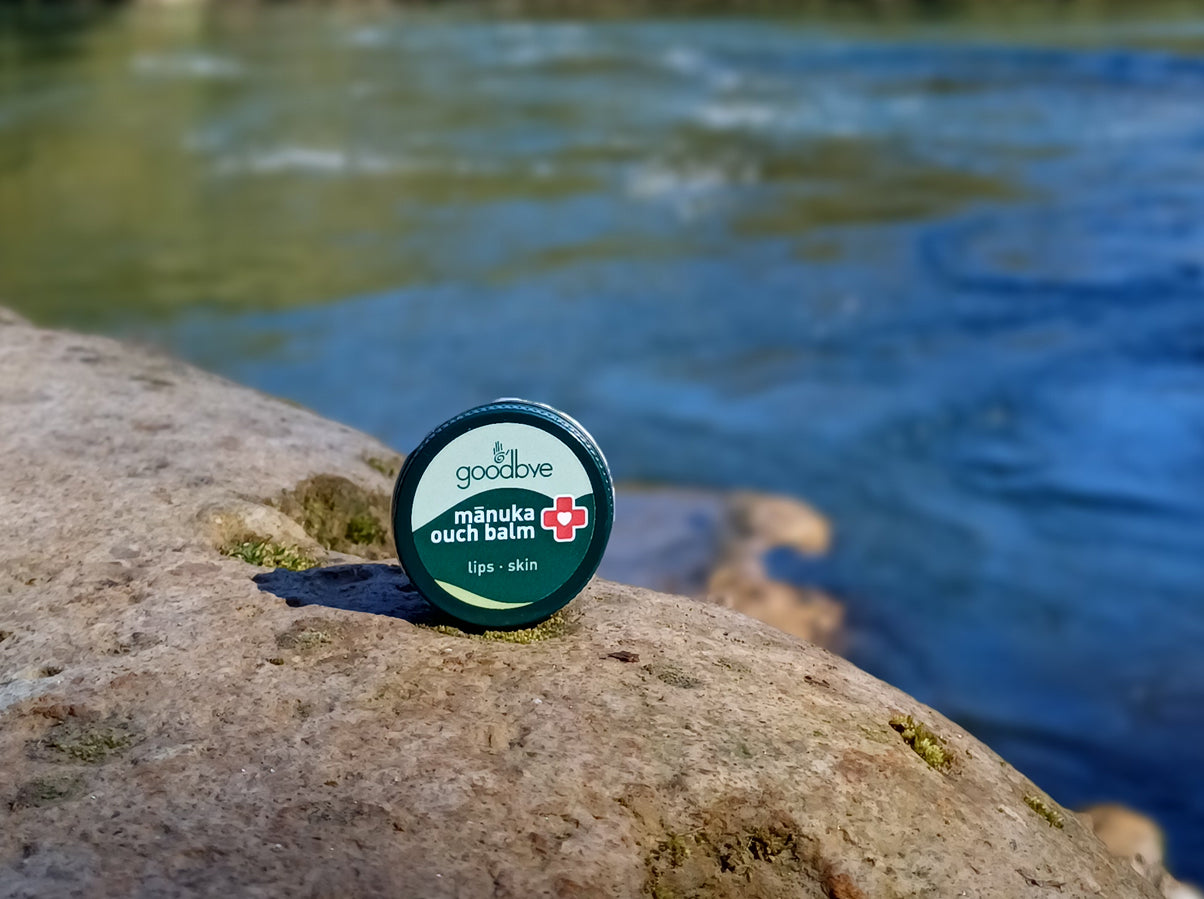There’s a lot of science and conversation about nanomaterials to sift through. We’ve taken years of learning and condensed it into as readable a form as possible. And if you’ve cared enough to get this far, we hope you’ll find the resources you need to make the best decisions for you and your family.
Nano
Nano Metre
A nanometre is a unit of length equivalent to 1 billionth of a metre. Simply put, a particle measured by nanometers (NM) means it is very small. 1000 NM equals 1 micron.
Primary Particle Size
Primary particle size refers to the size that zinc oxide is milled in the beginning of its process.
Secondary Particle Size
Secondary particle size is the result of a heat induced process that re-bonds lots of small particles into larger groups.
Sun Balm’s Zinc Oxide is made up of primary Nano Particles in the tens of nanometers range that form aggregates (clusters of nanoparticles with very strong bonds) that make up a nano porous structure with a secondary particle a few microns to tens of microns in size. Larger aggregates have a unique porous structure that provides a closer match between the refractive index of the particle and the refractive index of the emollient, resulting in high transparency.
In other words, for our zinc oxide, the result is that a bunch of nano-sized primary particles turn into much larger, strongly bonded micron-sized aggregates as a secondary particle. This allows the zinc to do its job, sit on the surface of the skin and yet not be white paste.
The unique aggregated porous structure provides both high UVB SPF and UVA protection.
It is this primary particle size that constitutes the requirement to label our Zinc Oxide (nano)
Our zinc has been tested for photo stability and these strong aggregates are stable under UV radiation.
Our Zinc Oxide was also tested using electron microscopy and obtained the following typical images. The clumps that you see are the secondary particles. They have a unique porous structure as shown in the SEM image below.

Nano Worldwide
Nano particles are essentially between 1 and 100NM (nano metre), but there is no consensus worldwide about thresholds for percentages of particles in this size of a material and other qualifications on what constitutes a nano material. Government agencies around the world are working to define, and update definitions. The EU is currently working to harmonise the definitions even amongst its own regulatory bodies.
Nano New Zealand
Since 2015, under the EPA, New Zealand cosmetics are required by law to label any nano material (NM) in their ingredients list with [nano]. Nano is a frontier for research across many industries from filters to fabrics to cosmetics, and not just minerals but plants too. New Zealand recognised that the consumer should know that this technology had been included in a particular formulation.
The New Zealand Cosmetic Group Standard follows the definition of the EU Cosmetic Regulation. Here is the current definition for New Zealand.
“Nanomaterial means an insoluble or biopersistent and intentionally manufactured material with one or more external dimensions, or an internal structure, on the scale from 1 to 100nm.”
Non-Nano
Many Zinc Oxide Sunscreens, and even some chemical sunscreens claim that their sunscreens are Non Nano. And while the median particle size may be say 140NM, there would still be a significant percentage of particles below 100NM.
In fact the EWG- Environmental Working Group in the USA, a respected independent NGO that does an extensive amount of sunscreen testing and analysis had this to say:
A number of companies sell products advertised as containing “non-nano” titanium dioxide and zinc oxide. These claims are generally misleading. While particle sizes vary among manufacturers, nearly all would be considered nanomaterials under a broad definition of the term, including the definition proposed in 2011 by the federal Food and Drug Administration (FDA 2011b).
The EU Cosmetic Regulation and NZ Cosmetic Group Standard definition for Nano has no threshold for amount of Nano particles required to be defined as Nano. If it is intentionally manufactured and has nanoparticles then it is a requirement to be labeled (Nano).
Non-nano or nano free can be also used as a marketing tool rather than as real information. In 2011 the Australian TGA put out this statement.
“Although labelling of therapeutic goods including sunscreens as ‘nanoparticle free’ is permitted, TGA remains concerned that promotion of goods as ‘nano free’ may imply that therapeutic goods that contain nanoparticles are unsafe when there is no evidence that this is the case,” a TGA spokeswoman said.
The Debate
The debate is over safety, and should rightly be given a great deal of attention. The nano question boils down to two critical questions for zinc oxide (and indeed all nano materials).
-
Does nano zinc penetrate the skin?
-
Does nano zinc generate Free Radicals and/or cause cell damage and if so where?
World wide many regulatory and independent bodies have surveyed the research and collated what is available to date. Each body needed to make their own safety decision on behalf of the public. Below are the statements from several major agencies around the world, each concluding that, from the research available to date, nano-zinc is safe for use in sunscreen.
European Union - SCCS
The debate is over safety, and should rightly be given a great deal of attention. The nano question boils down to two critical questions for zinc oxide (and indeed all nano materials).
-
Does nano zinc penetrate the skin?
-
Does nano zinc generate Free Radicals and/or cause cell damage and if so where?
World wide many regulatory and independent bodies have surveyed the research and collated what is available to date. Each body needed to make their own safety decision on behalf of the public. Below are the statements from several major agencies around the world, each concluding that, from the research available to date, nano-zinc is safe for use in sunscreen.
USA - EWG
USA- Environmental Working Group, a highly respected environmental non-profit
More research and more specific FDA guidelines are essential to reduce the risk and maximize the sun protection of mineral sunscreens. Yet, even with the existing uncertainties, we believe that zinc oxide and titanium dioxide lotions are among the best choices on the American market.
Here’s why:
- The shape and size of the particles affect sun protection.The smaller they are, the better the SPF protection and the worse the UVA protection. Manufacturers must strike a balance: small particles provide greater transparency but larger particles offer greater UVA protection. The form of zinc oxide most often used in sunscreens is larger and provides greater UVA protection than titanium dioxide products that appear clear on skin.
- Nanoparticles in sunscreen don’t penetrate the skin. Some studies indicate that nanoparticles can harm living cells and organs when administered in large doses. But a large number of studies have produced no evidence that zinc oxide nanoparticles can cross the skin in significant amounts (SCCS 2012). A real-world study tested penetration of zinc oxide particles of 19 and 110 nanometers on human volunteers who applied sunscreens twice daily for five days (Gulson 2010). Researchers found that less than 0.01 percent of either form of zinc entered the bloodstream. The study could not determine if the zinc in the bloodstream was insoluble nanoparticles, therefore the European regulators concluded it was most likely zinc ions, which would not pose any health risk (SCCS 2012). Other FDA- and European Union-sponsored studies concluded that nanoparticles did not penetrate the skin (NanoDerm 2007, Sadrieh 2010).
It is unlikely that nanoparticles in sunscreen cause skin damage when energized by sunlight. Titanium dioxide, and to a lesser extent zinc oxide, are photocatalysts, meaning that when they are exposed to UV radiation they can form free radicals that damage surrounding cells. Nanoparticle sizes of these minerals are more affected by UV rays than larger particles.
However, tests of living skin from human volunteers and animal testing suggest that these hazards are not a concern for human safety because the free radicals that are generated by nanoparticles on skin are quenched by the skin’s own antioxidant protections (Popov 2009, Osmond 2010).
EWG maintains ongoing vigilance in its assessment of sunscreen safety. At present, all available evidence suggests that zinc oxide and titanium dioxide can be safely used in sunscreen lotions applied to healthy skin. The weight of evidence indicates that both zinc oxide and titanium dioxide pose a lower hazard than most other sunscreen ingredients approved for the U.S. market.
Australia - TGA
Australia- Therapeutic Goods Administration
Of paramount importance is the finding that the vast majority of studies do not demonstrate NP skin penetration; the current weight of evidence suggests that TiO2and ZnO NPs do not reach viable skin cells (even in compromised skin) or the general circulation, but rather remain on the skin surface and in the outer layer of the stratum corneum, a surface layer of non-viable, keratinized cells. It is therefore highly likely that if sunscreens are used as is intended, NPs from sunscreens applied dermally will not achieve significant concentrations in the systemic circulation.
Consequently, it is highly unlikely that NPs will induce the cytotoxic responses or pathological outcomes outlined in this review in the in vitroand animal studies, respectively. The data from the reviewed in vitroexperiments should be interpreted with caution given that the findings from studies conducted in cell lines are of limited value in assessing the potential toxicity NPs pose to humans from topically applied sunscreens. Similarly, the limitations of the reviewed animal studies, where NPs were administered at relatively high concentrations through exposure routes that are not relevant in the context of sunscreen use and at high frequency, should also be acknowledged. Given the majority of studies found no evidence of skin penetration of NPs when applied dermally, it is highly unlikely that the high systemic NP concentrations attained in these experimental animals would be achieved in people, even if accidental intake occurred via these non-dermal routes. Therefore, any deductions made regarding the safety of topically applied sunscreens in humans by extrapolating these findings in animals to humans, are of limited value.
It is also crucial to emphasize that NPs present in sunscreens are modified to reduce their potential to generate ROS, which largely mediate NP-induced cytotoxicity and genotoxicity. During the manufacturing process the surface of the NPs may be coated to reduce the formation of ROS, even after UV exposure. Sunscreens may also contain antioxidants in order to neutralise ROS generated by NPs. Additionally, endogenous protective mechanisms, such as antioxidant activity mediated by a range of intracellular enzymes and factors, will likely protect against the damaging effects of oxidative stress generated by any exposure to nanoparticles. Minimal dermal penetration of NPs is likely to be adequately counteracted by these natural cellular defences.
In conclusion, on current evidence, neither TiO2 nor ZnO NPs are likely to cause harm when used as ingredients in sunscreens. The current state of knowledge strongly indicates that the minor risks potentially associated with NPs in sunscreens are vastly outweighed by the benefits that NP-containing sunscreens afford against skin damage and, importantly, skin cancer.
Sun Balm's Zinc Oxide
- Our Zinc Oxide is made up of Nano Particles in the tens of Nanometres that are strongly bonded together to form Non Nano Secondary Particle Clusters (Aggregates) that are porous in the few to tens of Microns in size.
- Zinc oxide sits on the outer, dead, layer of skin, and any free radicals generated will not affect living cells below.
- Our Zinc Oxide is very photo stable so generates much lower levels of Free Radicals
- Our supporting ingredients such as Organic Cocoa Butter, Jojoba Oil, Red Raspberry and Tamanu and more, provide powerful antioxidants which supports the skin to scavenge, or absorb, free radicals.

NATRUE Certification & Nano
- Our Zinc Oxide is made up of Nano Particles in the tens of Nanometres that are strongly bonded together to form Non Nano Secondary Particle Clusters (Aggregates) that are porous in the few to tens of Microns in size.
- Zinc oxide sits on the outer, dead, layer of skin, and any free radicals generated will not affect living cells below.
- Our Zinc Oxide is very photo stable so generates much lower levels of Free Radicals
- Our supporting ingredients such as Organic Cocoa Butter, Jojoba Oil, Red Raspberry and Tamanu and more, provide powerful antioxidants which supports the skin to scavenge, or absorb, free radicals.
Sun Balm – High Performance
This sunscreen did not come from a lab formulator or someone else’s base formula. It’s been hard won, because for us it was personal. We wanted something we could not find in any other sunscreen. Natural, high performance and a joy to use.
In 2012, we started with a baseline that we needed a “non nano” zinc. In the beginning, nano was like saying GMO, and like GMO we wanted to avoid it at all costs.
We worked through samples from most major zinc oxide manufacturers, new legislation, definitions and standards, screeds of data and research and howling press releases and forums. It was a big landscape, but the more we learned and the longer we looked, the more convinced we became that the nano/non-nano speak for zinc oxide is marketing rhetoric.
Sixty six formulations later, we believe that the best zinc oxide for sunscreen in the world is the one we now use. The combination of small particles agglomerated into larger particles gives a good wide spectrum of coverage in UVA as well as being balanced in UVB protection. This was not achievable in any zinc oxide until recently.
We not only had to understand the issues well enough to convince ourselves, we had to digest them long enough to be able to bring them to you with confidence.
As humans we are attempting to deal with the hole we ourselves have punched in the ozone. But it’s not only UV exposure that challenges our bodies. It’s oxidative stress from other environmental factors, pollution and the plethora of chemical cosmetics and sunscreens that seem to be so readily available.
We hope that one day, people will look back on this age and say, “What the heck were they thinking?” when it comes to the pollution and chemical product decisions common today.
And as with all things in life, while there are no absolutes, on the balance of every factor we took into consideration, we think Sun Balm is the best sunscreen on the market. Not just because of the zinc oxide that’s in Sun Balm, but because of the way we’ve woven it into a harmonious balance with the support of organic beeswax, plant oils, butters and waxes.
It did not happen easily and we’re grateful to be able to offer something extraordinary to our world.








